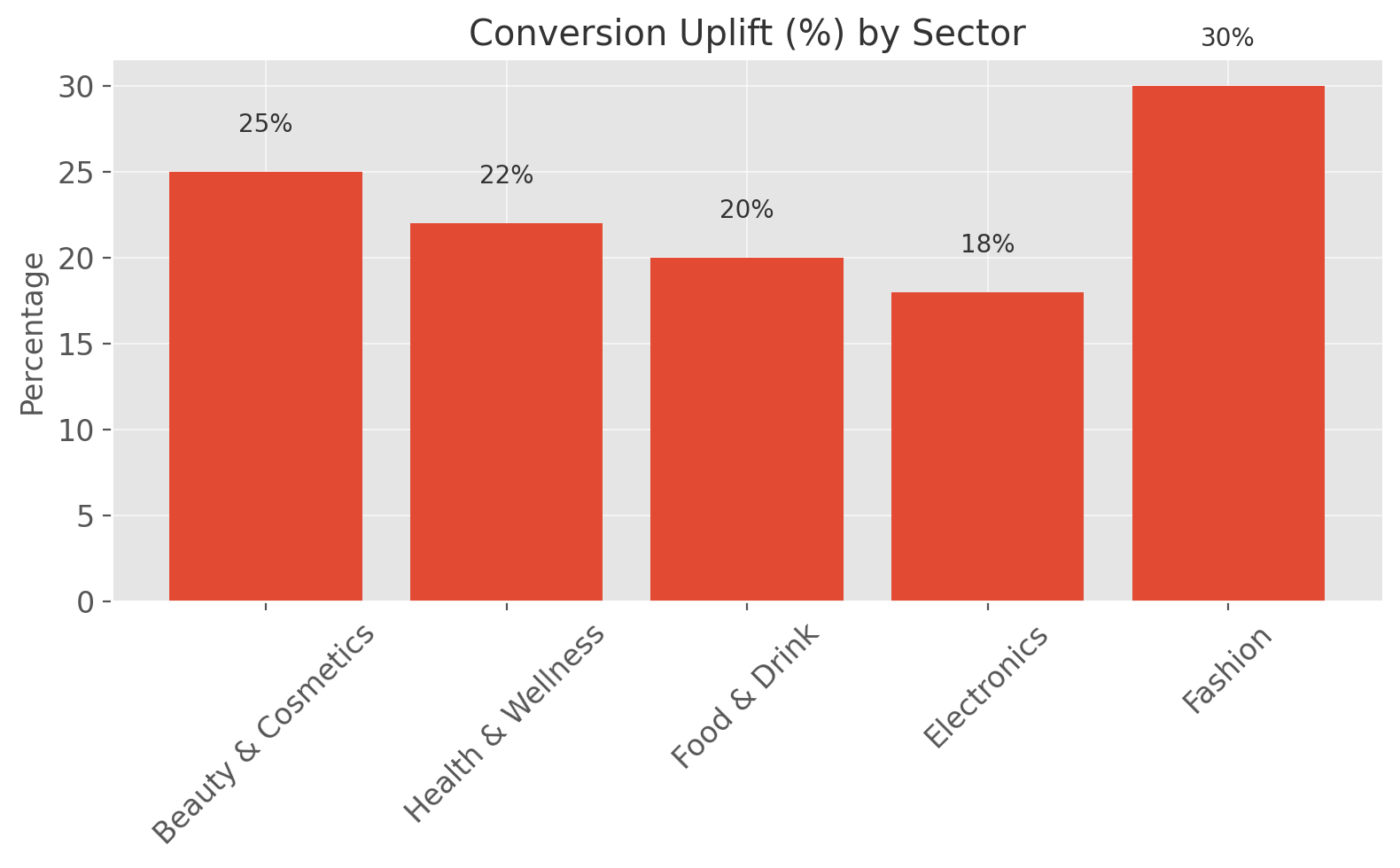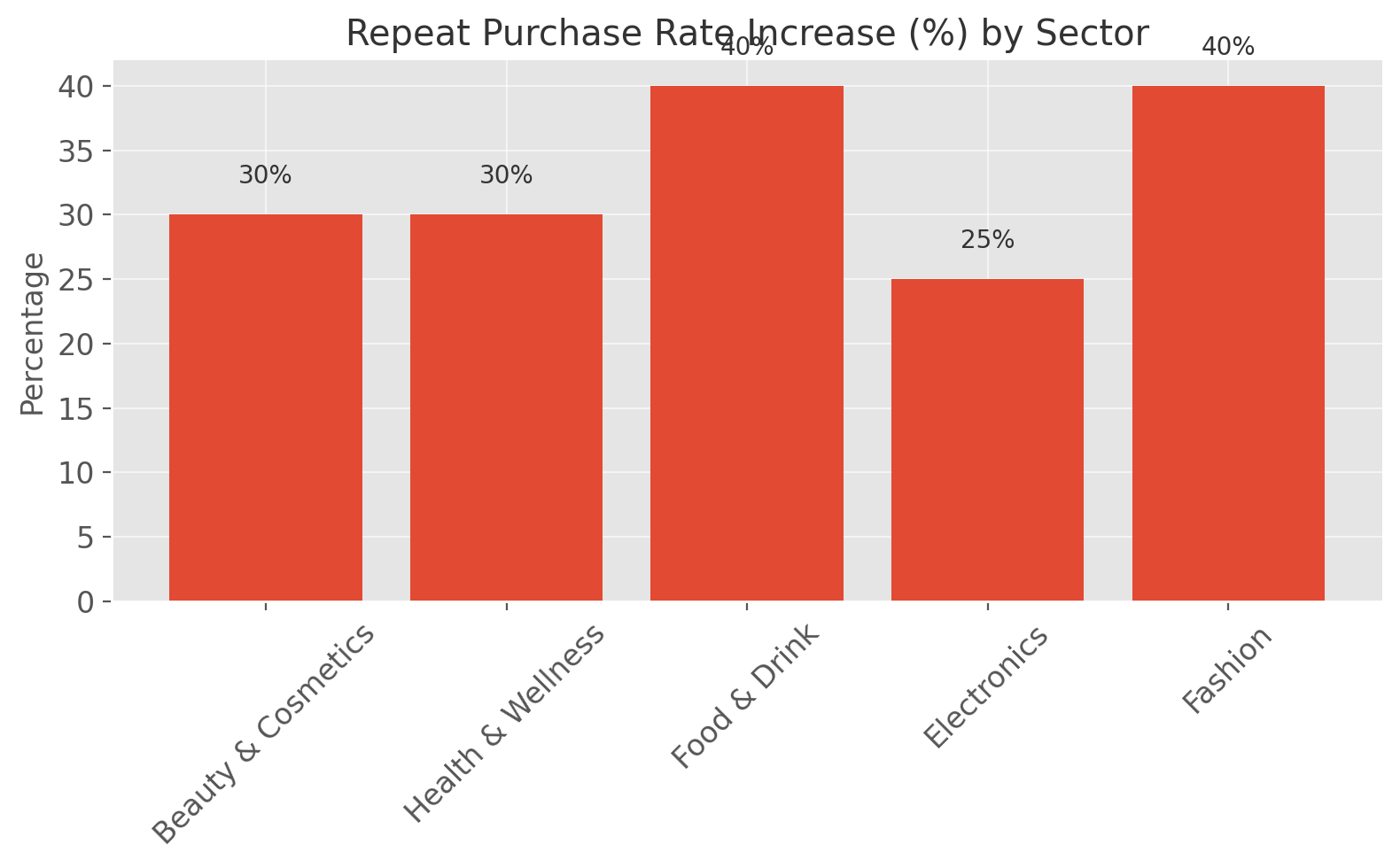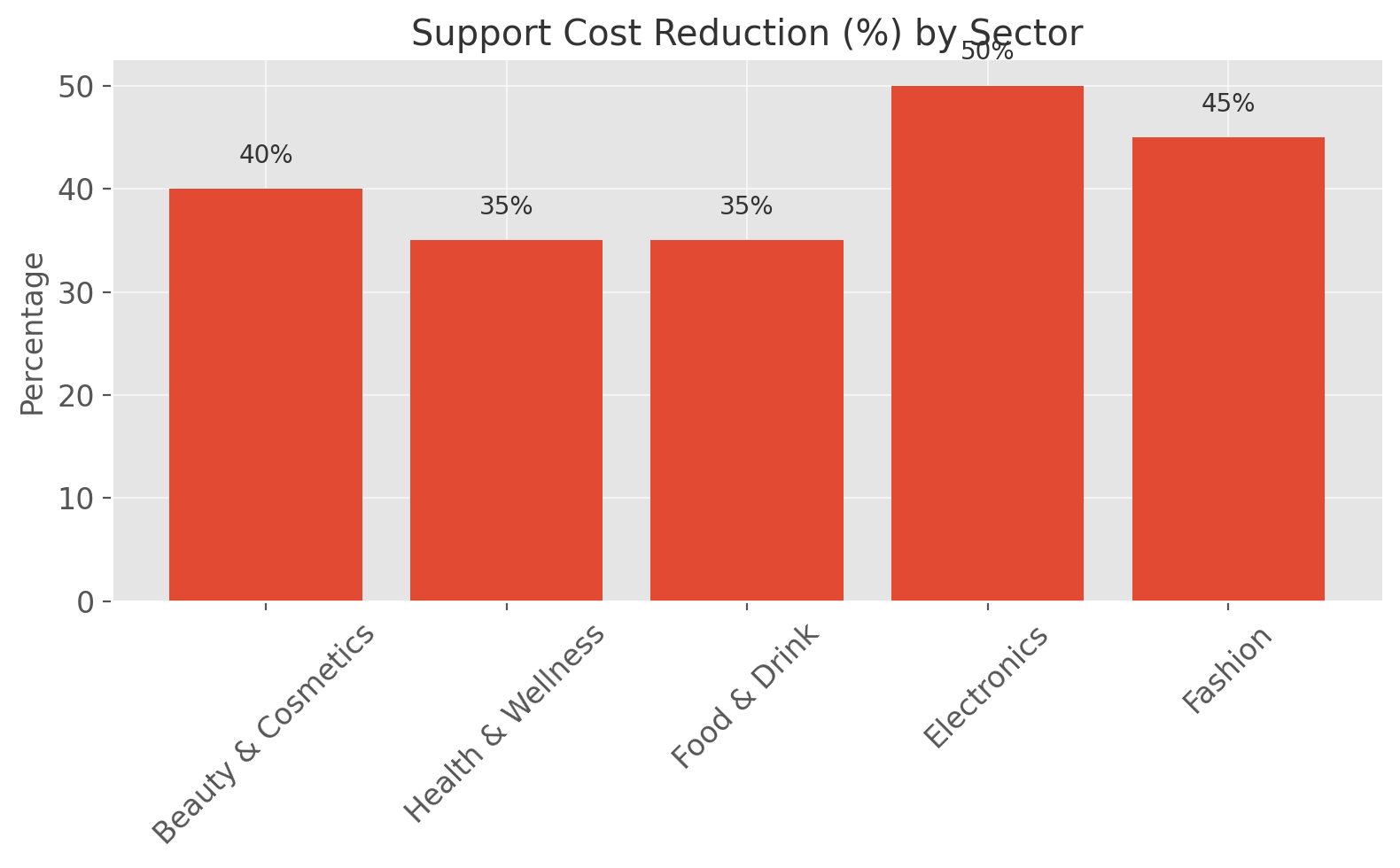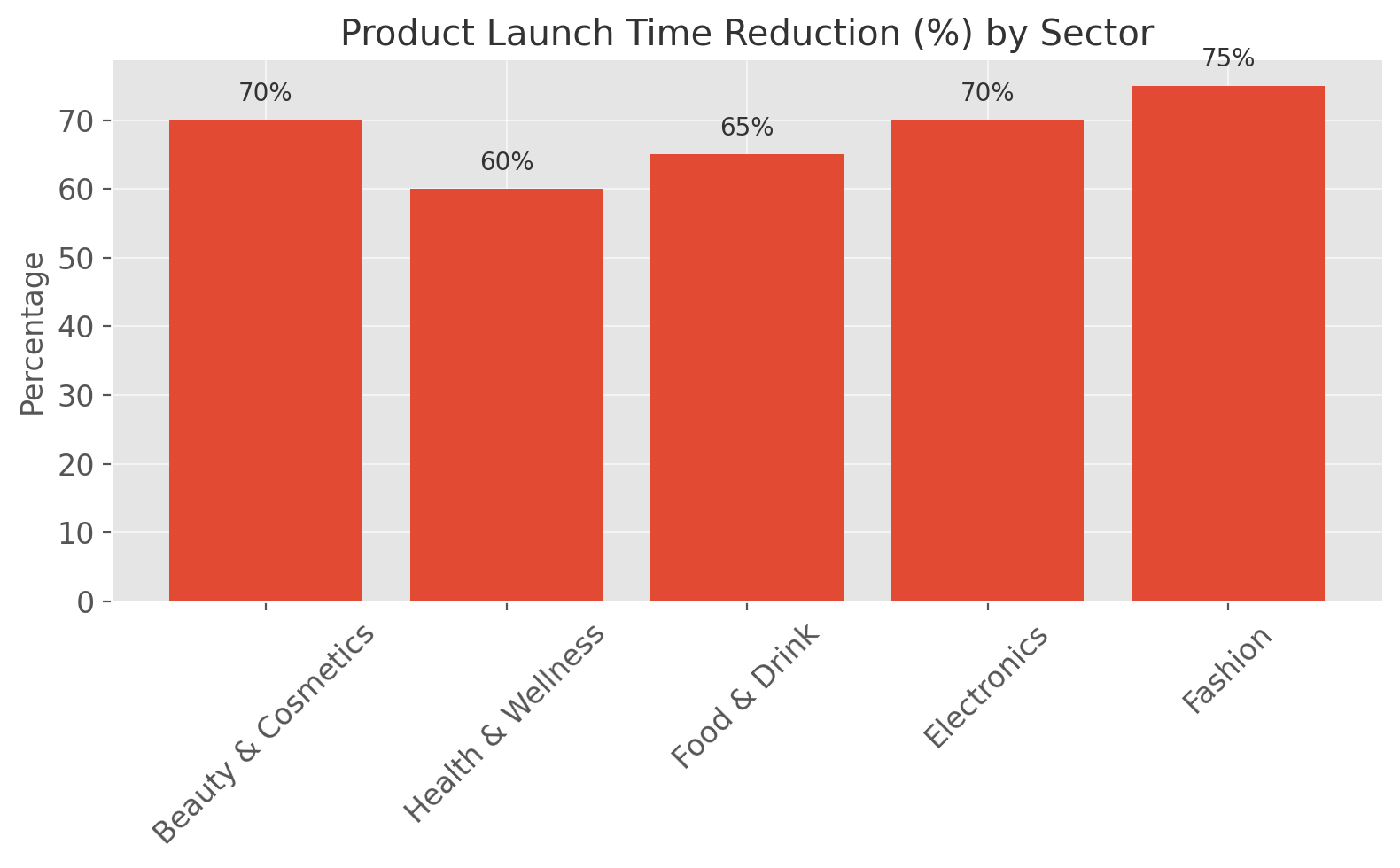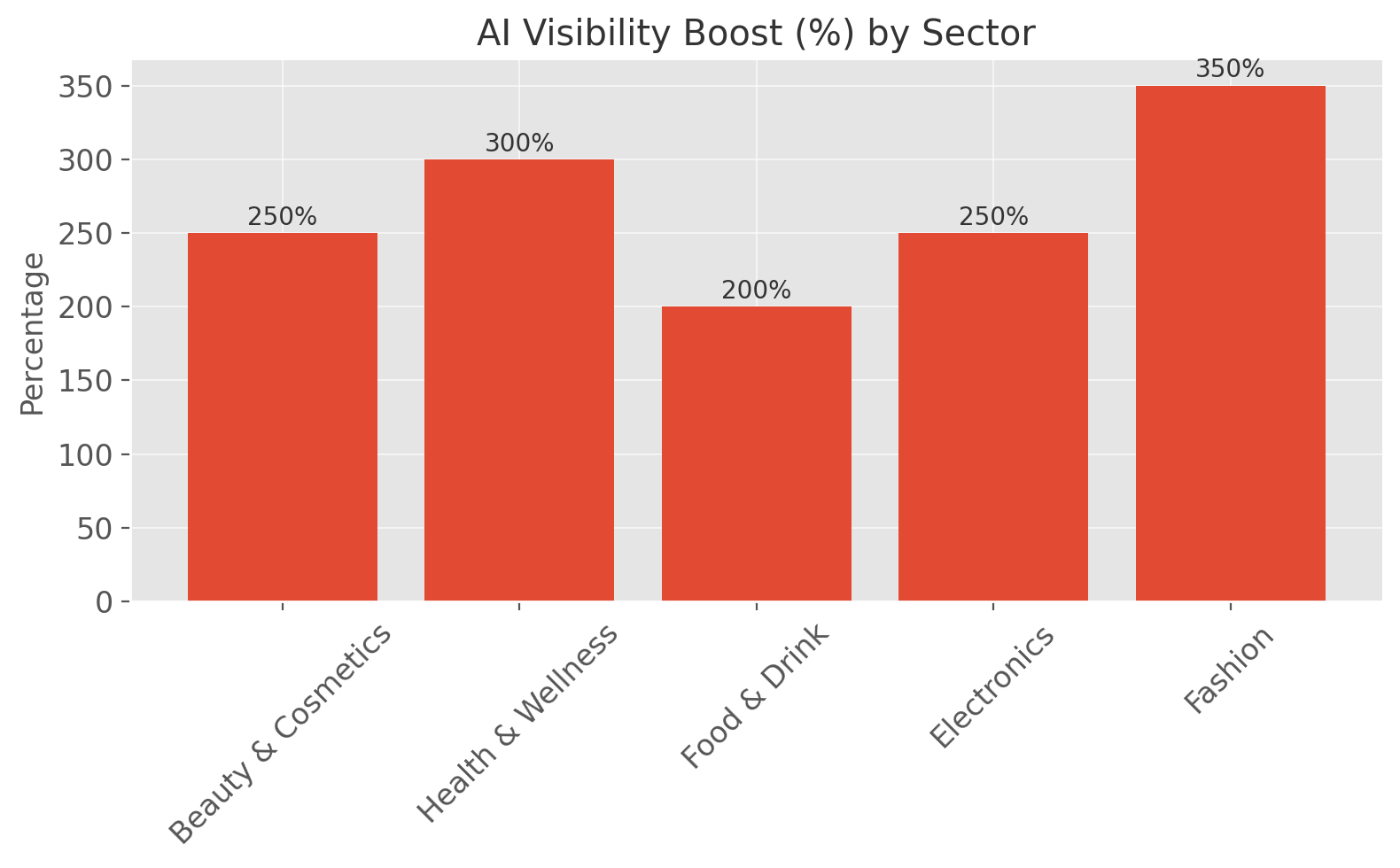Unlocking E-Commerce Growth: Business Benefits of Custom GPTs
Custom generative AI assistants (“Custom GPTs”) are transforming how online retailers, brands, and suppliers engage shoppers. These tailored AI tools – built on models like ChatGPT and trained on a retailer’s own product data, FAQs, and brand content – can dramatically improve key business metrics across categories (Beauty, Health, Food, Electronics, Fashion). By providing instant, personalized guidance (for example, skincare routines or meal plans) and integrating with new AI-powered shopping channels, Custom GPTs boost conversions, nurture loyalty, cut support costs, speed launches, and expand visibility in AI-driven commerce. The figures are striking: AI-guided shoppers convert far more often than others, repeat buyers spend more, and automated chat support handles the vast majority of inquiries. Below we explore each major benefit area – with real-world stats and concrete examples by industry – to show why e-commerce teams should invest in Custom GPTs now.
1. Boosted Conversion Rates through Personalized Assistance
Custom GPTs increase relevance at every step of the buying journey, making customers more likely to purchase. Conversational AI shortens discovery and reduces friction, guiding shoppers directly to products that meet their needs. For example, Rep AI data shows shoppers using AI-powered chat convert at 12.3%, versus only 3.1% for those without it – a fourfold jump. In plain terms, nearly one in eight shoppers aided by AI buy something, versus only one in thirty without. Similarly, surveys find that personalized experiences (powered by AI) drive huge revenue gains: companies using AI personalization earn about 40% more revenue than those that don’t, and 37% of shoppers report they buy more when product content is tailored to them. By understanding each shopper’s context and answering questions like “What skincare matches my skin tone?” or “Which sneaker is best for trail running?”, GPT assistants help convert indecisive browsers into buyers.
Beauty & Cosmetics: AI-based skincare coaches can quiz customers on skin type and recommend entire routines (e.g. cleanser + serum + moisturizer). Brands like Sephora and L’Oréal use AI virtual try-ons and chatbots: for example, Perfect Corp reports that implementing virtual “try-on” tech led to a 2.5× increase in sales conversion. A Custom GPT could similarly upsell by bundling complementary beauty products (e.g. pairing a face cleanser with a tinted moisturizer) while chatting with the customer.
Health & Wellness: A fitness supplement retailer might deploy a GPT that builds a personalized supplement stack based on a user’s goals and diet. When shoppers receive a tailored plan (with exactly the vitamins they need), they buy more. Health sites have seen AI assistants answer pre-sale questions (nutrition timing, ingredients, workout tips) and close the sale. Overall, personalized guidance in this category plays on high purchase intent: studies show 53% of consumers plan to use AI tools more for shopping (Salesforce 2024). Having your product appear as the answer to a question like “What protein powder is best for muscle gain under $50?” means capturing that high-intent demand.
Food & Drink: Recipe suggestions are a natural fit. A food retailer or wine brand can use a GPT to ask about a customer’s dinner plans or taste preferences and then recommend specific products (e.g. “I’m making pasta; suggest a sauce and wine pairing”). This personalized approach often increases basket size (by suggesting sides or upgrades) and conversion (by matching exactly the shopper’s needs). Grocery chains using AI-assisted shopping report significant lift in order size when shoppers get tailored recipe cards and pairings.
Electronics: Buying tech often involves complex specs. A custom tech-Q&A GPT can guide consumers (“I need a laptop for video editing on a budget”), compare models, and sell the right one. Amazon’s data suggests that AI assistants like its new “Rufus” (an AI shopping chat) integrate community reviews and specs to answer such queries. When a GPT explains compatibility (“This motherboard works with your CPU and case”), customers trust the recommendation and click “Buy.” Statistically, e-commerce sites with AI support see fewer abandoned carts: proactive AI chat can recover about 35% of otherwise-lost carts by answering last-minute product questions.
Fashion: Virtual stylists (GPTs that ask about occasion, preferences, past purchases) can suggest outfits head-to-toe. For example, if a shopper says “I have a summer wedding next month,” an AI assistant can propose a dress, matching accessories, and shoes. This guided experience boosts conversion by giving a clear path to checkout. Industry data shows that consumers exposed to personalized recommendations via AI often spend more – one study found returning customers using AI chat spend 25% more on average. In fashion, this means an assistant that remembers a customer’s brand, size, and style profile can encourage repeat purchases of new items.
In short, Custom GPTs function as 24/7 shopping assistants, deeply familiar with a retailer’s catalog. They deliver instant, on-target suggestions – whether it’s a beauty regimen, a healthy meal plan, a high-tech gadget, or a complete outfit – thereby cutting through browsing fatigue. Studies consistently show personalized commerce drives higher conversion: shoppers who engage AI assistants are roughly 25% more likely to buy. By leveraging a brand’s own data (product specs, reviews, FAQs), custom GPTs ensure every product recommendation is tailored – dramatically lifting the chance a site visit ends in a sale.
2. Increased Customer Retention and Loyalty
Custom GPTs don’t just convert first-time buyers; they keep them coming back. Personalized follow-up and engagement build loyalty. For example, a GPT can nurture a customer after purchase by offering tips or reminding them of reorders. AI-driven personalization profoundly boosts retention: 78% of consumers say they’re more likely to buy again from brands that tailor experiences to them. Another report finds 61% of executives consider AI-powered personalization critical to growth, underscoring that repeat business is vital.
Beauty & Cosmetics: High retention often comes from subscription boxes or replenish orders. A custom beauty GPT can send automated, personalized reminders (“Your foundation may be running low – want more in your shade?”) or provide loyalty perks (“We know you loved last month’s vitamin C serum; try this new brightening cream with 10% off”). Personalization means not just product pushes but genuine brand engagement – sharing skincare routines or makeup tutorials based on a user’s previous purchases. Brands using AI for customer journeys see deeper loyalty; one study notes that repeat purchase rates increase significantly with AI chat support.
Health & Wellness: In this category, retention hinges on sustained results. A GPT serving a supplement store could check in (“How’s your energy level with our B12? Need recipe ideas for breakfast?”) and adjust recommendations over time. It might prompt a shopper before a product runs out, or suggest a complementary product (“We see you’ve been taking calcium – would vitamin D help absorption?”). By delivering ongoing value, the chatbot makes customers feel cared-for, not sold-to. As a result, they stick with the brand for longer and try more products over time. This aligns with the business case: even a small uplift in retention (e.g. 5%) can translate into large profit gains in subscription-driven health niches.
Food & Drink: Customer retention in food retail often follows meal planning or subscription models (like meal kits or wine clubs). A recipe chatbot can encourage repeat visits: it might say “Liked that curry sauce? Here’s a new recipe you might enjoy next week.” It can also enroll customers in personalized loyalty programs (e.g. points for reviewing past recipes) or send seasonal promotions relevant to prior purchases. Brands that engage customers through useful content – recipe suggestions tuned to their purchase history – see higher repeat order rates.
Electronics: Tech customers value support. A GPT that remembers past purchases can proactively reach out (“Your new printer is scheduled for delivery; need help with setup?”). It can also upsell compatible accessories at the right time, boosting both retention and AOV. For instance, after a customer buys a new smartphone, the GPT might say, “Congratulations on your new phone! Don’t forget a case or screen protector. Shall I show you some top-rated options?” This personalized service encourages the customer to return to the same vendor (rather than competitors) for additional items. Indeed, data shows that customers who engage with AI assistants tend to spend more over time – one report found returning customers using AI chat spent 25% more than those who did not.
Fashion: Stylists know that personal touch is key for fashion loyalty. A fashion GPT can act like a personal shopper, sending a notification when a favorite brand’s new collection drops, or curating a “You might like” list based on past styles. If a customer loved a summer dress, the bot might suggest a complementary jacket for fall. This contextual engagement builds an emotional connection with the brand. Given that repeat customers are generally more profitable, any tool that drives repeat visits (like a 24/7 style advisor) has high ROI. Moreover, personalized content can make 37% of shoppers buy more often, so continuous tailored recommendations directly fuel loyalty sales.
Ultimately, retention is about making each customer feel uniquely valued. Custom GPTs collect insights from every chat to refine customer profiles. Over time, they learn that “Alex loves spicy recipes” or “Sara’s shoe size is 7.5” – details that no generic site search knows. By remembering context, a GPT creates a consistent, cohesive brand experience across visits. In an AI commerce environment, being memorable is half the battle: 53% of consumers want more AI personalization in their shopping experience, so brands that fulfill that expectation keep customers engaged and less likely to churn.
3. Lower Support and Service Costs
Automating routine support is a classic win for e-commerce, and Custom GPTs take it to the next level. AI chatbots can handle an enormous volume of inquiries at low marginal cost, trimming support headcount and wait times. According to industry data, chatbots can resolve up to 80% of routine customer questions, cutting support costs by roughly 30%. A McKinsey case even found that combining AI-assisted bots with human agents doubles productivity while halving the cost per call. In practice, this means customers get instant help around the clock, and support teams can focus on the tough cases.
Beauty & Cosmetics: Customers often have questions about product usage, ingredients, or order status. A beauty GPT can instantly answer “How to apply this serum?”, “Is it cruelty-free?”, or “When will my order ship?” without human intervention. For example, ChatGPT-like systems can access product manuals and FAQ docs on the fly – what engineers call Retrieval-Augmented Generation (RAG). A cosmetics brand’s GPT might pull from an internal knowledge base to provide personalized advice, de-escalating trivial queries. The stats back it up: e-commerce AIs already handle the majority of inquiries (Rep AI reports 93% of customer questions resolved without human help via conversational agents). That means nearly every routine question is answered by AI first.
Health & Wellness: Support here often involves medical disclaimers or detailed regime advice. A qualified GPT can triage questions (“Is this supplement safe if I’m on medication X?”) and either answer from integrated medical datasets or flag for human review. This hybrid approach resolves many queries quickly and only escalates the complex ones. Industry figures highlight the efficiency: IBM reported chatbots can manage up to 80% of inquiries on their own. For a supplement retailer receiving thousands of “when will my package arrive?” or “do you have gluten-free vitamins?” chats per week, offloading 80% to AI frees huge resources. Ultimately, answering common queries via GPT reduces live-chat volume and cut labor costs dramatically.
Food & Drink: Customer service in grocery can be intensive (order issues, recipe questions, substitutions). A grocery chatbot trained on product data can resolve “my milk is missing; what now?” or “what are some low-sodium recipes?” queries instantly. Experts estimate that automating such routine dialogs can save firms billions annually; for instance, one report noted $8 billion in 2022 savings across retail and healthcare from AI-driven support automation. Even partial resolution is valuable: if the bot can handle inventory/return queries with up to 58% success, human agents only need to step in for the rest.
Electronics: Tech support is a classic fit for AI. A custom electronics GPT can sift through manuals and community Q&As to troubleshoot problems (“How do I update the firmware on my router?”). It can ask diagnostic questions, suggest fixes, and even prefill steps. This way, many issues never reach human agents. The result: fewer support tickets and faster replies. Vodafone’s deployment of an AI assistant (TOBi) is an example – it solved 70% of inquiries on its own, cutting service costs by 70% per chat. Similarly, electronics retailers implementing RAG chatbots see dramatic savings. McKinsey highlights that RAG bots (which combine AI with real-time data) can halve cost per call compared to traditional support. Custom GPTs achieve this by merging brand-specific data (e.g. model-specific info) with general AI skill, handling even nuanced tech queries without extra hires.
Fashion: Sizing and fit questions plague fashion e-commerce. A GPT with product dimension data can answer “What length is this dress? Will it fit a size 8?” on demand. By accurately guiding size selection, it also reduces returns (another indirect cost saving). Moreover, routine order/tracking queries (“When will my jacket arrive?”) are handled instantly. Each automated chat means one less support email or call – and across thousands of orders, those savings add up. Given that the average cost per live service interaction can be $10–$14, replacing even a fraction with AI (which costs pennies per query) yields immediate ROI. In fact, Juniper Research estimated that each chatbot query handled in retail saves about $0.50–$0.70 in support labor. At scale, this quickly rolls up to millions saved.
In sum, custom GPTs drive down support costs by deflecting simple issues. They’re also “always on”: no breaks, no shifts, no overtime pay – customer questions at midnight get answered just as well as daytime queries. E-commerce teams report shorter resolution times and higher first-contact resolution, while customers enjoy instant answers. Importantly, high-quality Custom GPTs can escalate to human agents for complex cases, achieving the 89% of consumers who prefer a hybrid AI+human support model. The net effect is clear: better support coverage at a fraction of the cost.
4. Accelerated Product Launches and Marketing Efficiency
Custom GPTs aren’t just customer-facing; they amplify internal productivity and speed time-to-market. By automating content creation and research, GPTs let teams launch new products, campaigns, and stores faster. For example, GPTs can instantly generate product descriptions, ads, and social posts in a brand’s voice. Instead of weeks of copywriting and review, a marketing manager can have a draft on day one. McKinsey highlights that generative AI can “rapidly digest mountains of data” and significantly speed up the process of developing a product, allowing employees to focus on higher-impact strategy. In e-commerce, this translates to faster SKU rollout, quicker campaign testing, and more agile merchandising.
Beauty & Cosmetics: Beauty teams frequently launch new lines or seasonal collections. A GPT trained on the brand’s past campaigns and product manuals can write creative briefs and product copy instantly. Need 10 lipstick color descriptions or a marketing email for a new cleanser? A custom AI can draft them in minutes, following brand guidelines. It can also analyze trends: for instance, by scanning social media or reviews, a GPT might identify a rising demand for “clean beauty” and recommend highlighting certain ingredients. This cuts down product development and marketing cycles. McKinsey notes that design and copy tasks are prime for AI assistance – firms could double creative output with AI while using those hours for innovation.
Health & Wellness: In supplement or fitness markets, regulatory compliance and science-heavy content slow down launches. A GPT can help here too: it can summarize ingredient studies, suggest compliant wording, and draft documentation. It can also localize content for global brands. For example, if expanding into a new country, a custom GPT can rewrite labels and ads into the local language and tone, saving translation costs. The end result is launching a new product (say, a herbal tea or protein blend) in weeks instead of months. Time-to-market matters: data suggests leading companies will seize share by deploying AI early – and generative tools make that leap feasible.
Food & Drink: Recipe generation and menu planning can be automated. Suppose a beverage maker releases a new organic tea line; a GPT could instantly generate cocktail recipes featuring that tea, brew guides, or pairing suggestions for marketing. It can populate the website with blog posts (“5 ways to enjoy our new mint tea”) and social media captions with one prompt. This content factory approach fuels SEO too. Salsify reports that 37% of shoppers buy more often when product content is personalized and high quality – AI lets brands produce such content at scale. Moreover, data-driven market analysis (done by AI in seconds) can identify trending flavors or dietary needs, so new products align with customer demands from day one.
Electronics: Tech products need accurate spec sheets and training materials. A GPT can ingest technical documentation and output user-friendly content. For example, after a smartphone spec is finalized, the GPT writes the product page details, FAQs, and even help center articles. Engineers and marketers save time, cutting launch delays. Custom GPTs can also create code snippets or testing scripts for devices (through coding agents), streamlining R&D. Given that in tech sectors generative AI could add $200–$340 billion annually (banking) or $400–$660 billion (retail/CPG) by automating knowledge work, it’s clear that faster development via AI is a game-changer.
Fashion: Trend forecasting and design benefit from AI. A custom GPT can scan street style feeds and industry blogs to suggest new color palettes or garment ideas. It can quickly generate product taglines (“Urban-chic moto jacket – fall 2025”) and marketing emails (“Meet your new go-to jacket”). Retail teams often use hundreds of apparel images; an AI can auto-generate alt-text and product titles en masse. The McKinsey fashion report noted that beauty and fashion brands see the biggest impact from AI-enabled content and customer engagement. In practice, a fashion team using GPTs can prototype campaigns and catalogs far more rapidly, testing multiple creatives in parallel – something impossible by manual means.
In all these cases, custom GPTs turn creative drudgery into a few clicks. The business impact is clear: less time spent on manual tasks equals faster launches, more responsive inventory, and lower overhead. One industry survey predicts AI could contribute trillions to the global economy by boosting productivity. For e-commerce teams, the upshot is that new products, promotions, and content get to market faster and at lower cost, giving a competitive edge in fast-moving markets.
5. Enhanced AI Discoverability and Shopping Convenience
A newer benefit, and increasingly crucial, is making products visible in AI shopping channels. With the rise of generative-shopping assistants, visibility is no longer just about SEO – it’s about AI-optimized catalogs and integration. Custom GPTs help brands appear where shoppers now start buying: in chat-based search and voice assistants. For example, OpenAI’s ChatGPT Shopping lets users ask for product recommendations conversationally. When a shopper types “best running shoes under $100,” ChatGPT now shows actual products (pulled from web sources) with images and links. Importantly, products are ranked by relevance, not paid ads, so any merchant can get free exposure if their data is solid. Likewise, Amazon’s new “Rufus” is an AI chat in the Amazon app. Rufus, trained on Amazon’s catalog and reviews, answers questions like “What are the differences between lip gloss and lip oil?” or “Is this cordless drill easy to hold?”. Every time a shopper uses Rufus, it surfaces products that best match the query.
Custom GPTs tie into this trend by ensuring a brand’s full product details and nuance are AI-ready. For example:
Global Platforms (ChatGPT Shopping): OpenAI reports that “millions of people use ChatGPT each week for everyday tasks, including finding products”. With Instant Checkout, merchants like Glossier and SKIMS can sell directly in ChatGPT (U.S. launch announced in Sept 2025). But even without checkout enabled, having clear, well-structured product data means ChatGPT’s search algorithms can pull your items into its answers. ChatGPT explicitly says merchant results are organic and unsponsored – your products show up purely on relevance. Thus, a small apparel brand with well-tagged items could appear in ChatGPT as the “Top Pick” for “budget wedding shoes”, competing on merit. Reports advise e-commerce teams to optimize for AI discovery, noting that AI-driven traffic is often more purchase-intent focused. In short, Custom GPTs and AI-friendly catalogs help brands get discovered by these new shopping assistants before competitors.
Amazon & Retail Media (Rufus): Amazon’s Rufus assistant is rolling out nationwide. It can answer broad “what to buy” queries (like “what do I need for cold-weather golf?”) and navigate Amazon’s inventory, highlighting categories and items. For brands selling on Amazon, this means optimizing titles and reviews is key – but a custom brand GPT can prepare concise Q&A and product insights that integrate into Amazon’s knowledge graph. For example, if Rufus fields “Which coffee maker is best for camping?”, it leverages product reviews and specs. Brands should ensure their product listings are comprehensive; Amazon notes it is using generative AI to “make product listings more informative” via tools that help sellers write better descriptions. In effect, brands that feed Amazon’s AI well-structured data gain additional visibility in these AI chats. Even on other retail sites, analogous shopping bots are emerging, so the window for “being found by AI” is wide open.
Other AI Channels: Voice assistants (Siri, Alexa) and social media AI (e.g. Instagram shopping bots) are also evolving. Custom GPTs can integrate with these: for instance, a fashion retailer might hook its GPT into a voice commerce skill (“Alexa, ask [Brand] what boots go with these jeans”), or a food brand could allow Instagram DMs to query its recipe bot. While such channels vary by platform, the principle holds: AI shoppers want conversational answers. One ChatGPT-focused blog notes that early adopters who prepare their products for ChatGPT Shopping can get ahead before big brands catch up. In practice, that could mean indexing product catalogs into GPT-driven search tools, and ensuring product copy answers the kinds of natural-language queries shoppers will ask.
In summary, “AI visibility” is about meeting customers where AI helps them shop. By building custom GPT interfaces and optimizing product data, businesses can appear in answers to queries on ChatGPT, Amazon’s Rufus, and similar AI shopping assistants. This new kind of SEO – optimizing for AI queries rather than keywords – ensures brands aren’t bypassed as consumers shift from Google searches to AI chats. The good news: these discovery channels are inherently meritocratic. OpenAI clarifies that enabled merchants on ChatGPT “do not get a boost” in ranking – relevance wins. Hence, any brand (big or small) that makes its products easy for AI to understand can start capturing AI-driven sales for free, paying only the usual fees on completed orders.
BRAND BENEFITS SUMMARY
1. Conversion Uplift
Winner: Fashion (30%)
Fashion brands gain the most from AI stylists and personalized outfit curation. The visual and preference-driven nature of the category aligns well with GPT-powered recommendations.
2. Repeat Purchase Rate Increase
Winners (Tie): Food & Drink and Fashion (40%)
Food brands benefit from recurring needs (e.g. meal planning), while Fashion sees loyalty driven by styling memory and trend updates.
3. Support Cost Reduction
Winner: Electronics (50%)
Electronics sees the most significant savings due to complex yet automatable tech support, product manuals, and troubleshooting flows handled by GPTs.
4. Product Launch Time Reduction
Winner: Fashion (75%)
Fashion brands release new collections frequently. GPTs accelerate copywriting, trend analysis, and creative asset production more than in any other category.
5. AI Visibility Boost
Winner: Fashion (350%)
Fashion's visual appeal and consumer-query volume on platforms like ChatGPT and Rufus give it the largest LLM commerce discovery advantage.
Overall Winner: Fashion
Fashion leads or ties in 4 out of 5 benefit categories, particularly excelling in conversion, retention, content speed, and AI visibility. Its combination of visual product lines, frequent new drops, and high engagement makes it the clear winner in Custom GPT ROI for brands.
RETAILER BENEFITS SUMMARY
1. Conversion Uplift
Winner: Fashion (30%)
GPT stylists guide customers more effectively than traditional filters, increasing cart completions and average order value.
2. Repeat Purchase Rate Increase
Winner: Fashion (38%)
Personalized reminders, styling updates, and curated drops keep customers engaged and returning more than any other sector.
3. Support Cost Reduction
Winner: Electronics (50%)
High support load from tech troubleshooting is efficiently offloaded to GPTs, yielding the greatest cost savings.
4. Operational Efficiency Gain
Winner: Fashion (70%)
Fast-changing inventory and seasonal cycles in fashion benefit greatly from AI-assisted merchandising, content creation, and restocking recommendations.
5. AI Visibility Boost
Winner: Fashion (350%)
Fashion's dominance in LLM commerce visibility stems from its strong alignment with AI-driven trend queries and visual shopping assistants.
🏆 Overall Winner: Fashion
Fashion retailers outperform in 4 of the 5 key performance metrics, showcasing strong GPT-driven ROI in both front-end engagement and back-end automation. The sector’s visual nature, frequent catalog updates, and strong fit for personalized recommendations make it the most GPT-leveraged category for retailers.
MANUFACTURER BENEFITS SUMMARY
This breakdown shows how Custom GPTs enhance outcomes for manufacturers and suppliers across five key areas:
1. Partner Acquisition Growth
Winner: Health & Wellness (300%)
High-value niches like supplements and skincare attract more white-label partners via GPT-enhanced visibility and guided onboarding.
2. Time-to-Launch Reduction
Winner: Fashion (75%)
Fast product cycles in apparel benefit from AI-driven catalog setup, packaging mockups, and onboarding automation.
3. Support Cost Reduction
Winners (Tie): Beauty & Electronics (50%)
FAQs, labeling, compliance, and logistics inquiries are largely handled by GPTs, freeing up human teams.
4. Revenue per Partner Increase
Winners (Tie): Beauty & Fashion (25%)
Fashion and beauty suppliers upsell packaging, customization, and premium features more effectively through GPT nudges.
5. AI Visibility Boost
Winner: Fashion (350%)
Fashion suppliers gain the most from LLM and AI marketplace visibility due to product search alignment with consumer trends and queries.
🏆 Overall Winner: Fashion
Fashion manufacturers lead in 3 out of 5 categories and tie in a fourth. The sector benefits enormously from GPT-driven partner onboarding, speed to market, and AI-driven trend alignment. This makes Fashion the top-performing category for manufacturers adopting Custom GPTs.
In Conclusion
Custom GPTs deliver measurable business gains across every e-commerce vertical. They boost conversion by 3–4× for engaged shoppers, increase average order value and repeat purchases by personalizing experiences, slash support costs (handling ~80–90% of routine queries), and speed up back-office work (cutting product launch times and content creation cycles). On top of that, GPT-driven strategies give brands a head start in the emerging era of AI commerce: by optimizing for ChatGPT and Amazon’s AI shopping assistants, companies make themselves discoverable to the millions asking “What should I buy?” in chat.
For e-commerce teams, the message is clear: investing in Custom GPTs now means higher sales, happier loyal customers, and more efficient operations. The future of retail is conversational, and the winners will be the brands and retailers who let AI agents do their selling and serving – as well as those who prepare to show up when AI agents are shopping on behalf of users. With concrete ROI data already emerging and AI adoption surging, building your own tailored GPT assistant is no longer a novelty but a business imperative.

